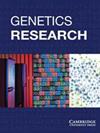The Bioinformatical Identification of Potential Biomarkers in Heart Failure Diagnosis and Treatment
IF 2.1
4区 生物学
Q4 GENETICS & HEREDITY
引用次数: 2
Abstract
Background Heart failure (HF) is defined as the inability of the heart's systolic and diastolic function to properly discharge blood flow from the veins to the heart. The goal of our research is to look into the possible mechanism that causes HF. Methods The GSE5406 database was used for screening the differentially expressed genes (DEGs). Gene ontology (GO), Kyoto Encyclopedia of Genes and Genomes (KEGG), and Protein-Protein Interaction (PPI) network were applied to analyze DEGs. Besides, cell counting Kit-8 (CCK-8) was conducted to observe the knockdown effect of hub genes on cell proliferation. Results Finally, 377 upregulated and 461 downregulated DEGs came out, enriched in the extracellular matrix organization and gap junction. According to GSEA results, Hoft cd4 positive alpha beta memory t cell bcg vaccine age 18–45 yo id 7 dy top 100 deg ex vivo up, Sobolev t cell pandemrix age 18–64 yo 7 dy dn, and so on were significantly related to gene set GSE5406. 7 hub genes, such as COL1A1, UBB, COL3A1, HSP90AA1, MYC, STAT3 and MAPK1, were selected from PPI networks. CCK-8 indicated silencing of STAT3 promoted the proliferation of H9C2 cells and silencing of UBB inhibited the proliferation of H9C2 cells. Conclusion Our analysis reveals that COL1A1, UBB, COL3A1, HSP90AA1, MYC, STAT3, and MAPK1 might promote the progression of HF and become the biomarkers for diagnosis and treatment of HF.心力衰竭诊断和治疗中潜在生物标志物的生物信息学鉴定
背景心力衰竭(HF)是指心脏的收缩和舒张功能无法将血液从静脉正确排出到心脏。本研究的目的是探讨HF的可能机制。方法利用GSE5406数据库筛选差异表达基因。应用基因本体论(GO)、京都基因与基因组百科全书(KEGG)和蛋白质-蛋白质相互作用(PPI)网络对DEG进行分析。此外,通过细胞计数Kit-8(CCK-8)观察hub基因对细胞增殖的敲除作用。结果共产生377个上调和461个下调的DEG,富集于细胞外基质组织和间隙连接。根据GSEA结果,Hoft cd4阳性α-β记忆t细胞bcg疫苗年龄为18-45岁 yo-id 7 dy top 100 deg离体向上,Sobolev t细胞pandemrix年龄18-64岁 yo 7 dy-dn等与基因集GSE5406显著相关。从PPI网络中筛选出COL1A1、UBB、COL3A1、HSP90AA1、MYC、STAT3和MAPK1等7个枢纽基因。CCK-8表明STAT3的沉默促进H9C2细胞的增殖,而UBB的沉默抑制H9C2的增殖。结论COL1A1、UBB、COL3A1、HSP90AA1、MYC、STAT3和MAPK1可能促进HF的进展,成为诊断和治疗HF的生物标志物。
本文章由计算机程序翻译,如有差异,请以英文原文为准。
求助全文
约1分钟内获得全文
求助全文
来源期刊

Genetics research
生物-遗传学
自引率
6.70%
发文量
74
审稿时长
>12 weeks
期刊介绍:
Genetics Research is a key forum for original research on all aspects of human and animal genetics, reporting key findings on genomes, genes, mutations and molecular interactions, extending out to developmental, evolutionary, and population genetics as well as ethical, legal and social aspects. Our aim is to lead to a better understanding of genetic processes in health and disease. The journal focuses on the use of new technologies, such as next generation sequencing together with bioinformatics analysis, to produce increasingly detailed views of how genes function in tissues and how these genes perform, individually or collectively, in normal development and disease aetiology. The journal publishes original work, review articles, short papers, computational studies, and novel methods and techniques in research covering humans and well-established genetic organisms. Key subject areas include medical genetics, genomics, human evolutionary and population genetics, bioinformatics, genetics of complex traits, molecular and developmental genetics, Evo-Devo, quantitative and statistical genetics, behavioural genetics and environmental genetics. The breadth and quality of research make the journal an invaluable resource for medical geneticists, molecular biologists, bioinformaticians and researchers involved in genetic basis of diseases, evolutionary and developmental studies.
 求助内容:
求助内容: 应助结果提醒方式:
应助结果提醒方式:


